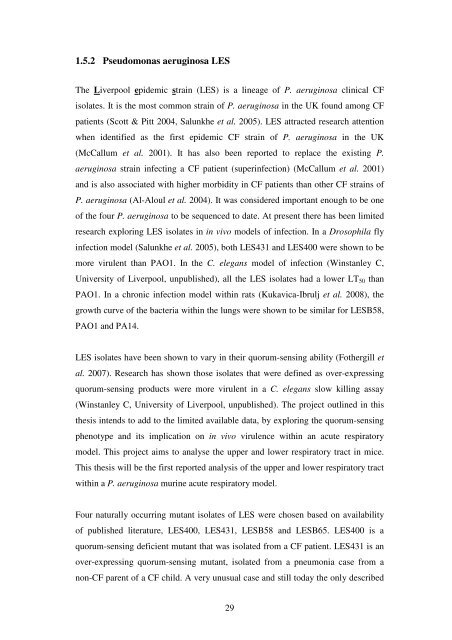5 The role of quorum-sensing in the virulence of Pseudomonas ...
5 The role of quorum-sensing in the virulence of Pseudomonas ...
5 The role of quorum-sensing in the virulence of Pseudomonas ...
You also want an ePaper? Increase the reach of your titles
YUMPU automatically turns print PDFs into web optimized ePapers that Google loves.
1.5.2 <strong>Pseudomonas</strong> aerug<strong>in</strong>osa LES<br />
<strong>The</strong> Liverpool epidemic stra<strong>in</strong> (LES) is a l<strong>in</strong>eage <strong>of</strong> P. aerug<strong>in</strong>osa cl<strong>in</strong>ical CF<br />
isolates. It is <strong>the</strong> most common stra<strong>in</strong> <strong>of</strong> P. aerug<strong>in</strong>osa <strong>in</strong> <strong>the</strong> UK found among CF<br />
patients (Scott & Pitt 2004, Salunkhe et al. 2005). LES attracted research attention<br />
when identified as <strong>the</strong> first epidemic CF stra<strong>in</strong> <strong>of</strong> P. aerug<strong>in</strong>osa <strong>in</strong> <strong>the</strong> UK<br />
(McCallum et al. 2001). It has also been reported to replace <strong>the</strong> exist<strong>in</strong>g P.<br />
aerug<strong>in</strong>osa stra<strong>in</strong> <strong>in</strong>fect<strong>in</strong>g a CF patient (super<strong>in</strong>fection) (McCallum et al. 2001)<br />
and is also associated with higher morbidity <strong>in</strong> CF patients than o<strong>the</strong>r CF stra<strong>in</strong>s <strong>of</strong><br />
P. aerug<strong>in</strong>osa (Al-Aloul et al. 2004). It was considered important enough to be one<br />
<strong>of</strong> <strong>the</strong> four P. aerug<strong>in</strong>osa to be sequenced to date. At present <strong>the</strong>re has been limited<br />
research explor<strong>in</strong>g LES isolates <strong>in</strong> <strong>in</strong> vivo models <strong>of</strong> <strong>in</strong>fection. In a Drosophila fly<br />
<strong>in</strong>fection model (Salunkhe et al. 2005), both LES431 and LES400 were shown to be<br />
more virulent than PAO1. In <strong>the</strong> C. elegans model <strong>of</strong> <strong>in</strong>fection (W<strong>in</strong>stanley C,<br />
University <strong>of</strong> Liverpool, unpublished), all <strong>the</strong> LES isolates had a lower LT50 than<br />
PAO1. In a chronic <strong>in</strong>fection model with<strong>in</strong> rats (Kukavica-Ibrulj et al. 2008), <strong>the</strong><br />
growth curve <strong>of</strong> <strong>the</strong> bacteria with<strong>in</strong> <strong>the</strong> lungs were shown to be similar for LESB58,<br />
PAO1 and PA14.<br />
LES isolates have been shown to vary <strong>in</strong> <strong>the</strong>ir <strong>quorum</strong>-<strong>sens<strong>in</strong>g</strong> ability (Fo<strong>the</strong>rgill et<br />
al. 2007). Research has shown those isolates that were def<strong>in</strong>ed as over-express<strong>in</strong>g<br />
<strong>quorum</strong>-<strong>sens<strong>in</strong>g</strong> products were more virulent <strong>in</strong> a C. elegans slow kill<strong>in</strong>g assay<br />
(W<strong>in</strong>stanley C, University <strong>of</strong> Liverpool, unpublished). <strong>The</strong> project outl<strong>in</strong>ed <strong>in</strong> this<br />
<strong>the</strong>sis <strong>in</strong>tends to add to <strong>the</strong> limited available data, by explor<strong>in</strong>g <strong>the</strong> <strong>quorum</strong>-<strong>sens<strong>in</strong>g</strong><br />
phenotype and its implication on <strong>in</strong> vivo <strong>virulence</strong> with<strong>in</strong> an acute respiratory<br />
model. This project aims to analyse <strong>the</strong> upper and lower respiratory tract <strong>in</strong> mice.<br />
This <strong>the</strong>sis will be <strong>the</strong> first reported analysis <strong>of</strong> <strong>the</strong> upper and lower respiratory tract<br />
with<strong>in</strong> a P. aerug<strong>in</strong>osa mur<strong>in</strong>e acute respiratory model.<br />
Four naturally occurr<strong>in</strong>g mutant isolates <strong>of</strong> LES were chosen based on availability<br />
<strong>of</strong> published literature, LES400, LES431, LESB58 and LESB65. LES400 is a<br />
<strong>quorum</strong>-<strong>sens<strong>in</strong>g</strong> deficient mutant that was isolated from a CF patient. LES431 is an<br />
over-express<strong>in</strong>g <strong>quorum</strong>-<strong>sens<strong>in</strong>g</strong> mutant, isolated from a pneumonia case from a<br />
non-CF parent <strong>of</strong> a CF child. A very unusual case and still today <strong>the</strong> only described<br />
29














